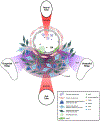Bloodhounds chasing the origin of blood cells
- PMID: 40221343
- PMCID: PMC12353867
- DOI: 10.1016/j.tcb.2025.03.003
Bloodhounds chasing the origin of blood cells
Abstract
The generation of blood cells during embryonic development involves a process resembling lineage reprogramming, where specialized cells within the vasculature become blood forming, or hemogenic. These hemogenic cells undergo rapid transcriptional and morphological changes as they appear to switch from an endothelial to blood identity. What controls this process and the exact nature of the hemogenic cells remains debated, with evidence supporting several hypotheses. In this opinion, we synthesize current knowledge and propose a model reconciling conflicting observations, integrating evolutionary and mechanistic insights into blood cell emergence.
Keywords: endothelial cells; hemangioblast; hematopoietic development; hematopoietic stem cells; hemogenesis.
Copyright © 2025 Elsevier Ltd. All rights reserved.
Conflict of interest statement
Declaration of interests The authors declare no competing interests related to this work.
Figures





Similar articles
-
Short-Term Memory Impairment.2024 Jun 8. In: StatPearls [Internet]. Treasure Island (FL): StatPearls Publishing; 2025 Jan–. 2024 Jun 8. In: StatPearls [Internet]. Treasure Island (FL): StatPearls Publishing; 2025 Jan–. PMID: 31424720 Free Books & Documents.
-
Prescription of Controlled Substances: Benefits and Risks.2025 Jul 6. In: StatPearls [Internet]. Treasure Island (FL): StatPearls Publishing; 2025 Jan–. 2025 Jul 6. In: StatPearls [Internet]. Treasure Island (FL): StatPearls Publishing; 2025 Jan–. PMID: 30726003 Free Books & Documents.
-
Sexual Harassment and Prevention Training.2024 Mar 29. In: StatPearls [Internet]. Treasure Island (FL): StatPearls Publishing; 2025 Jan–. 2024 Mar 29. In: StatPearls [Internet]. Treasure Island (FL): StatPearls Publishing; 2025 Jan–. PMID: 36508513 Free Books & Documents.
-
Stem cell insights into human trophoblast lineage differentiation.Hum Reprod Update. 2016 Dec;23(1):77-103. doi: 10.1093/humupd/dmw026. Epub 2016 Sep 2. Hum Reprod Update. 2016. PMID: 27591247
-
The Lived Experience of Autistic Adults in Employment: A Systematic Search and Synthesis.Autism Adulthood. 2024 Dec 2;6(4):495-509. doi: 10.1089/aut.2022.0114. eCollection 2024 Dec. Autism Adulthood. 2024. PMID: 40018061 Review.
References
-
- Sabin FR (1917) Preliminary note on the differentiation of angioblasts and the method by which they produce blood-vessels, blood-plasma and red blood-cells as seen in the living chick. Anat. Rec 13, 199–204 - PubMed
-
- Murray (1932) The development of the blood vessels and blood cells in the chick embryo. Proceedings of the National Academy of Sciences of the United States of America 6, 161–166
-
- Choi K et al. (1998) A common precursor for hematopoietic and endothelial cells. Development 125, 725–732 - PubMed
-
- Huber TL et al. (2004) Haemangioblast commitment is initiated in the primitive streak of the mouse embryo. Nature 432, 625–630 - PubMed
Publication types
Grants and funding
LinkOut - more resources
Full Text Sources

